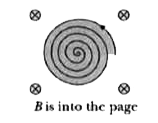From the matrix equation AB = AC we can conclude B = C provided that
A
A is singular
B
A is non-singular.
C
A is symmetric.
D
A is square
Video Solution
Text Solution
The correct Answer is:B
|
Answer
Step by step video, text & image solution for From the matrix equation AB = AC we can conclude B = C provided that by Maths experts to help you in doubts & scoring excellent marks in Class 12 exams.
Updated on:21/07/2023Topper's Solved these Questions
- MATRICESBOOK - TARGET PUBLICATIONCHAPTER - MATRICESEXERCISE - CLASSICAL THINKING (2.3 APPLICATION OF MATRICES)
3 Videos
- MATRICESBOOK - TARGET PUBLICATIONCHAPTER - MATRICESEXERCISE - CLASSICAL THINKING (MISCELLANEOUS)
2 Videos
- MATHEMATICAL LOGIC BOOK - TARGET PUBLICATIONCHAPTER - MATHEMATICAL LOGIC EXERCISE - EVALUATION TEST
14 Videos
- MHT-CET 2019 QUESTION PAPER BOOK - TARGET PUBLICATIONCHAPTER - MHT-CET 2019 QUESTION PAPER EXERCISE - Binomial Distribution
1 Videos
Similar Questions
Knowledge Check
From the matrix equation AB=AC we can conclude B=C provided the matrix A is
Am×mBn×nCn×mDm×nFrom the matrix equation AB=AC, we conclude B=C provided.
AA is singularBA is non-singularCA is symmetricDA is a squareFrom the matrix equation AB = AC, which one of the following can be concluded ?
AB = C for any matrix ABB = C, if A is singularCB = C, if A is non-singularDA = B = C for any matrix A
Tension in the cable supporting an elevator, is equal to the weight of the elevator. From this, we can conclude that the elevator is going up or down with a
View SolutionFrom the following V−T diagram we can conclude:-
_E01_054_Q01.png)
View Solution
Regarding the nature of the charge, we can conclude that :
View SolutionFrom the electrochemical series, it can be concluded that :
View SolutionIn a certain region of space, the electric field is zero. From this, we can conclude that the electric potential in this region is:
View Solution
